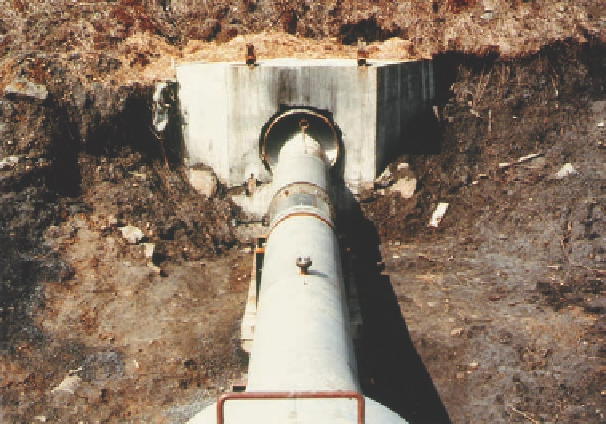Geology Reference
In-Depth Information
support and by sealing fissures in the ground surface. In terms of air pollution, test data indicated that all the fuel
-
sulfur appeared as SO
X
in the exhaust, but only 5% of the fuel
-
nitrogen appeared as NO
X
. From an environmental
viewpoint, removal of SO
X
and NO
X
from the exhaust will be required if Burnout Control is developed to a
commercial system.
Albright Waste Bank
The second trial of Burnout Control was a 1-year test of the process as applied to a 0.9-acre section of a 6.5-acre
abandoned coal waste-pile fire, the Albright Waste Bank Fire Project in West Virginia (Chaiken and Bayles,1988).
The field trial of Burnout Control at the Albright waste pile was designed to operate at a 5MW (thermal), 900°C
exhaust output. At Albright, a 0.9m (3 ft) diameter, 42.7-m (140 ft)-long stainless-steel combustion manifold was
set horizontally at the bottom of the pile along its base (Figure 16.5.3.). A 15.2-m (50 ft)-long perforated section of
the manifold served to draw heat and fumes from a volume of waste estimated at over 10 000 tons, which at the
design output would have taken 0.75 year to burn producing 28 494 billion thermochemical calories (113 billion
BTU) of thermal energy. Engineering design problems and the need to control air pollution during the trial
prevented long-term continuous burnout operations at the site. However, during 1600 hours of fan operations,
an estimated 700 tons of waste were burned producing 2048 billion thermochemical calories (8.12 billion BTU) of
exhaust thermal energy. Burnout operations were terminated when excessive temperatures and vacuum combined
to collapse the combustion manifold.
A key finding at the Albright field trial was that, as the fire was spread under Burnout Control, the pile acted as a
large gasifier that required the after burn of the exhaust gases in the combustion manifold. Only 30% of the fuel
-
sulfur appeared in the exhaust, but without full stoichiometric burning, reduced sulfur gases (e.g., H
2
S, COS, and
CS
2
) in the exhaust caused odor problems for nearby residents. Subsidence occurred on top of the waste pile over
the fire zones, but the holes were readily filled. With improved engineering designs with regard to maintaining the
structural integrity of the combustion manifold and improving its operation as an afterburner, Burnout Control
could be applied to controlling coal waste-pile fires.
Water Injection
R
emoving heat, one of the three essential elements, from an underground fire requires the introduction of a heat-
absorbing medium, its controlled movement through the mine, and the removal of the heated substance (Dalverny,
Figure 16.5.3. Photograph of a combustion manifold and a steel liner inserted into the Albright waste bank. From
Chaiken and Bayles 1991, p. 10.



